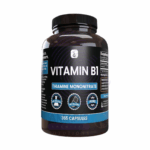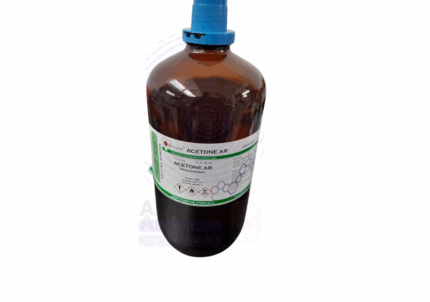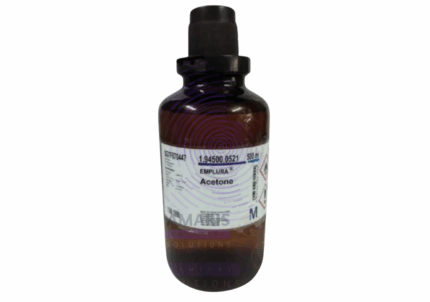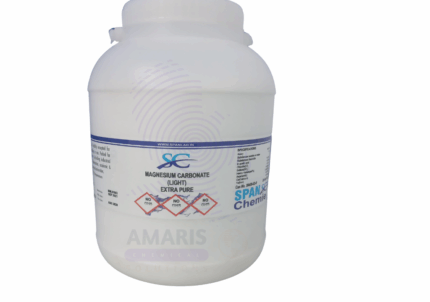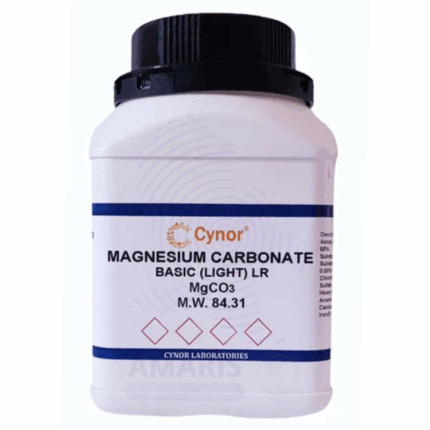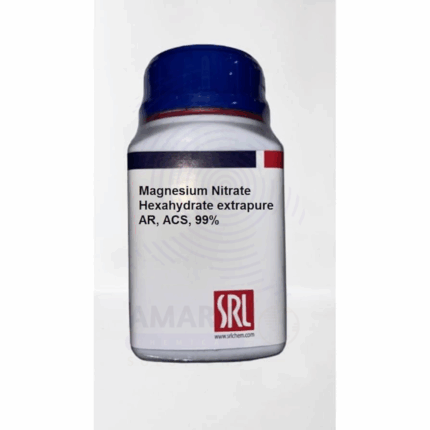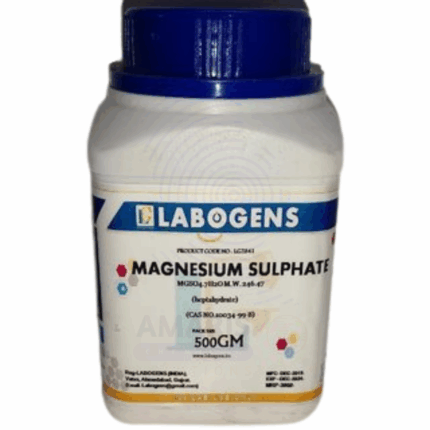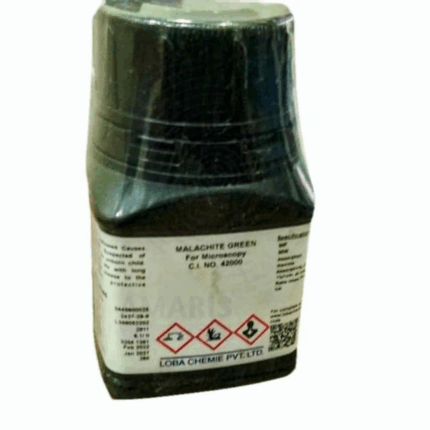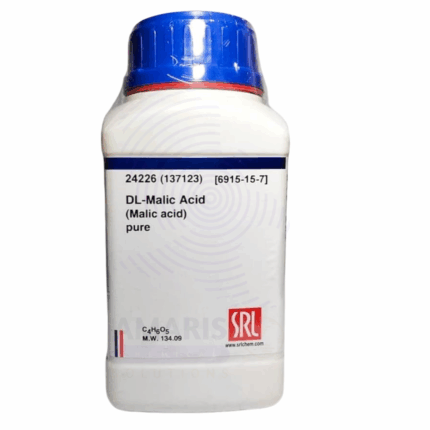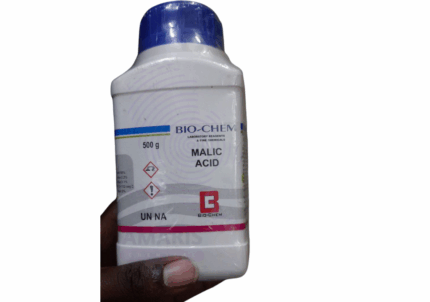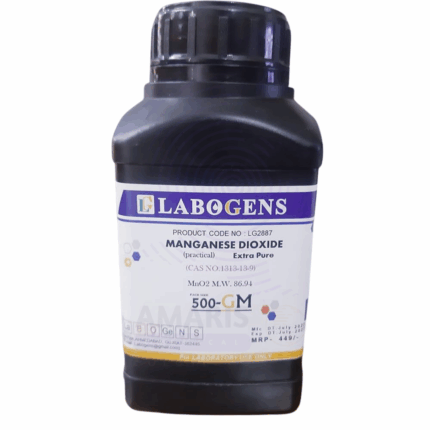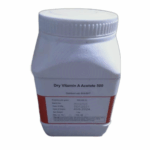
Vitamin B1 Thiamine HCL Extra Pure
$ 16.21 Original price was: $ 16.21.$ 16.09Current price is: $ 16.09.
Vitamin B1 Thiamine HCL Extra Pure is a high-purity, white to off-white crystalline powder widely used in pharmaceutical, nutritional, and laboratory applications. Known for its essential role as a water-soluble vitamin critical for carbohydrate metabolism and nerve function, it serves as a key ingredient in supplements and fortified foods. This Extra Pure grade meets strict purity standards suitable for analytical, research, and pharmaceutical formulations. Sensitive to light, heat, and alkaline conditions, it should be stored properly to maintain stability. Handling precautions include avoiding dust inhalation and skin contact. Its safety profile is favorable with minimal hazards under normal use.
Vitamin B1 Thiamine HCL Extra Pure
PRIMARY USES
- Analytical Reagent & Laboratory Applications
- Used as a reference standard in vitamin B1 quantification by HPLC, microbiological, and spectrophotometric methods
- Employed in biochemical and molecular biology research to study thiamine-dependent enzymes and metabolic pathways
- Utilized in quality control and stability testing of vitamin B1 products
- Applied in cell culture media to investigate thiamine’s role in cellular metabolism and energy production
- Pharmaceutical & Nutraceutical Industry
- Active ingredient in oral and parenteral vitamin B1 supplements for prevention and treatment of thiamine deficiency diseases such as beriberi and Wernicke-Korsakoff syndrome
- Incorporated into multivitamin complexes supporting nervous system health and carbohydrate metabolism
- Used in intravenous and intramuscular injections for acute therapeutic needs
- Formulated in sustained-release tablets and capsules for improved absorption and efficacy
SECONDARY USES
- Food Industry (in regulated quantities)
- Fortificant in fortified cereals, bakery products, nutritional beverages, and infant formulas to enhance dietary intake
- Added to animal feed supplements to promote livestock growth and metabolic health
- Used in food processing for enrichment and labeling as a vitamin source
- Cosmetic and Personal Care Industry
- Occasionally included in skin care products for its antioxidant and skin conditioning effects
1. Basic Identification Attributes
- Chemical Name: Thiamine Hydrochloride (Vitamin B1 HCl)
- CAS Number: 67-03-8
- HS Code: 2936.29.00
- Molecular Formula: C₁₂H₁₇ClN₄OS
- Synonyms: Thiamine HCl, Vitamin B1 Hydrochloride, Aneurin
2. Physical & Chemical Properties
- Physical State: Fine crystalline powder
- Color & Odor: White to off-white, odorless
- Melting Point: 247–250 °C (decomposes)
- Solubility: Highly soluble in water (~50 g/100 mL at 20 °C), slightly soluble in ethanol
- Stability: Sensitive to alkaline conditions, light, and heat; stable in acidic environments
- pH Level: Slightly acidic aqueous solutions
3. Safety & Hazard Attributes
- Hazard Class (GHS Classification): Not classified as hazardous under normal use
- NFPA Ratings: Health 1, Flammability 0, Reactivity 0
- Exposure Limits: No specific OSHA PEL or ACGIH TLV established
- Reactivity: Stable under recommended storage conditions
4. Storage & Handling Attributes
- Storage Conditions: Store in cool, dry, dark, well-ventilated place
- Incompatible Materials: Strong bases and oxidizing agents
- Container Type: Sealed opaque containers or amber glass bottles
- Shelf Life & Expiration Date: Stable for 2–3 years if stored properly
- Special Handling Requirements: Use gloves, avoid dust inhalation, handle in well-ventilated areas
5. Regulatory & Compliance Attributes
- Regulatory Status: Approved for pharmaceutical, food, and nutraceutical use by FDA and other authorities
- Transportation Restrictions: Not classified as hazardous for transport
6. Environmental & Health Impact
- Ecotoxicity: Low toxicity to aquatic organisms
- Persistence in Environment: Biodegradable under aerobic conditions
- Carcinogenicity/Mutagenicity: Not classified as carcinogenic or mutagenic
- Biodegradability: Biodegradable
SAFETY PRECAUTIONS
Personal Protective Equipment (PPE):
- Wear chemical-resistant gloves
- Use safety goggles
- Wear lab coat or protective clothing
- Use dust mask if dust is generated
Handling:
- Handle in a well-ventilated area
- Avoid contact with skin, eyes, and clothing
- Do not inhale dust
- Wash hands thoroughly after handling
Storage:
- Store in tightly closed containers
- Keep in cool, dry, dark environment
- Avoid exposure to heat, light, and incompatible materials
FIRST AID MEASURES
Inhalation:
- Move to fresh air immediately
- Seek medical attention if breathing difficulty occurs
Skin Contact:
- Wash thoroughly with soap and water
- Remove contaminated clothing
- Seek medical advice if irritation occurs
Eye Contact:
- Rinse immediately with plenty of water for at least 15 minutes
- Seek medical attention if irritation persists
Ingestion:
- Rinse mouth with water
- Do not induce vomiting unless advised
- Seek medical attention if symptoms appear
FIRE FIGHTING MEASURES
Flammability:
- Combustible but not highly flammable
Extinguishing Media:
- Use dry chemical, CO₂, foam, or water spray
Hazardous Combustion Products:
- May produce carbon monoxide, carbon dioxide, nitrogen oxides, sulfur oxides, and hydrochloric acid fumes
Firefighter Protection:
- Wear self-contained breathing apparatus (SCBA) and full protective gear
- Avoid inhaling combustion products


 Preservatives(food)
Preservatives(food) Flavor Enhancers
Flavor Enhancers Acidulants
Acidulants Sweeteners
Sweeteners Antioxidants
Antioxidants Colorants(food)
Colorants(food) Nutraceutical Ingredients (food)
Nutraceutical Ingredients (food) Nutrient Supplements
Nutrient Supplements Emulsifiers
Emulsifiers
 Collectors
Collectors Dust Suppressants
Dust Suppressants Explosives and Blasting Agents
Explosives and Blasting Agents Flocculants and Coagulants
Flocculants and Coagulants Frothers
Frothers Leaching Agents
Leaching Agents pH Modifiers
pH Modifiers Precious Metal Extraction Agents
Precious Metal Extraction Agents
 Antioxidants(plastic)
Antioxidants(plastic) Colorants (Pigments, Dyes)
Colorants (Pigments, Dyes) Fillers and Reinforcements
Fillers and Reinforcements Flame Retardants
Flame Retardants Monomers
Monomers Plasticizers
Plasticizers Polymerization Initiators
Polymerization Initiators Stabilizers (UV, Heat)
Stabilizers (UV, Heat)
 Antifoaming Agents
Antifoaming Agents Chelating Agents
Chelating Agents Coagulants and Flocculants
Coagulants and Flocculants Corrosion Inhibitors
Corrosion Inhibitors Disinfectants and Biocides
Disinfectants and Biocides Oxidizing Agents
Oxidizing Agents pH Adjusters
pH Adjusters Scale Inhibitors( water)
Scale Inhibitors( water)
 Antioxidants(cosmetic)
Antioxidants(cosmetic) Emollients
Emollients Fragrances and Essential Oils
Fragrances and Essential Oils Humectants
Humectants Preservatives
Preservatives Surfactants(cosmetic)
Surfactants(cosmetic) Thickeners
Thickeners UV Filters
UV Filters
 Fertilizers
Fertilizers Soil Conditioners
Soil Conditioners Plant Growth Regulators
Plant Growth Regulators Animal Feed Additives
Animal Feed Additives Biostimulants
Biostimulants Pesticides (Herbicides, Insecticides, Fungicides)
Pesticides (Herbicides, Insecticides, Fungicides)
 Active Pharmaceutical Ingredients (APIs)
Active Pharmaceutical Ingredients (APIs) Excipients
Excipients Solvents(pharmaceutical)
Solvents(pharmaceutical) Antibiotics
Antibiotics Antiseptics and Disinfectants
Antiseptics and Disinfectants Vaccine Adjuvants
Vaccine Adjuvants Nutraceutical Ingredients (pharmaceutical)
Nutraceutical Ingredients (pharmaceutical) Analgesics & Antipyretics
Analgesics & Antipyretics
 Analytical Reagents
Analytical Reagents Solvents(lab)
Solvents(lab) Chromatography Chemicals
Chromatography Chemicals Spectroscopy Reagents
Spectroscopy Reagents microbiology-and-cell-culture-reagents
microbiology-and-cell-culture-reagents Molecular Biology Reagents
Molecular Biology Reagents Biochemical Reagents
Biochemical Reagents Inorganic and Organic Standards
Inorganic and Organic Standards Laboratory Safety Chemicals
Laboratory Safety Chemicals Specialty Laboratory Chemicals(Special Laboratory Equipment)
Specialty Laboratory Chemicals(Special Laboratory Equipment)
 Demulsifiers
Demulsifiers Hydraulic Fracturing Fluids
Hydraulic Fracturing Fluids Scale Inhibitors(oil)
Scale Inhibitors(oil) Surfactants(oil)
Surfactants(oil) Drilling Fluids
Drilling Fluids
 Dyes and Pigments
Dyes and Pigments Bleaching Agents
Bleaching Agents Softening Agents
Softening Agents Finishing Agents
Finishing Agents Antistatic Agents
Antistatic Agents
 Admixtures
Admixtures Waterproofing Agents
Waterproofing Agents Sealants and Adhesives
Sealants and Adhesives Curing Compounds
Curing Compounds Concrete Repair Chemicals
Concrete Repair Chemicals Anti-Corrosion Coatings
Anti-Corrosion Coatings
 Surfactants(cleaning)
Surfactants(cleaning) Builders
Builders Enzymes
Enzymes Solvents (Cleaning)
Solvents (Cleaning) Fragrances
Fragrances
 Electronic Chemicals
Electronic Chemicals Catalysts
Catalysts Lubricants
Lubricants Photographic Chemicals
Photographic Chemicals Refrigerants
Refrigerants Automotive chemicals
Automotive chemicals Pyrotechnic Chemicals
Pyrotechnic Chemicals
 Biodegradable Surfactants
Biodegradable Surfactants Bio-based Solvents
Bio-based Solvents Renewable Polymers
Renewable Polymers Carbon Capture Chemicals
Carbon Capture Chemicals Wastewater Treatment Chemicals
Wastewater Treatment Chemicals
 Pigments
Pigments Solvents(paint)
Solvents(paint) Specialty Coatings
Specialty Coatings Binders/Resins
Binders/Resins Additives
Additives Driers
Driers Anti-Corrosion Agents
Anti-Corrosion Agents Functional Coatings
Functional Coatings Application-Specific Coatings
Application-Specific Coatings
 Fresh Herbs
Fresh Herbs Ground Spices
Ground Spices Whole Spices
Whole Spices Spice Blends
Spice Blends Dried Herbs
Dried Herbs
 Leavening Agents
Leavening Agents Dough Conditioners
Dough Conditioners Flour Treatments
Flour Treatments Fat Replacers
Fat Replacers Decoratives
Decoratives Preservatives(baking)
Preservatives(baking)
 Plasticizers & Softeners
Plasticizers & Softeners Reinforcing Agents
Reinforcing Agents Adhesion Promoters
Adhesion Promoters Vulcanizing Agents
Vulcanizing Agents Antidegradants
Antidegradants Blowing Agents
Blowing Agents Fillers & Extenders
Fillers & Extenders Accelerators & Retarders
Accelerators & Retarders
